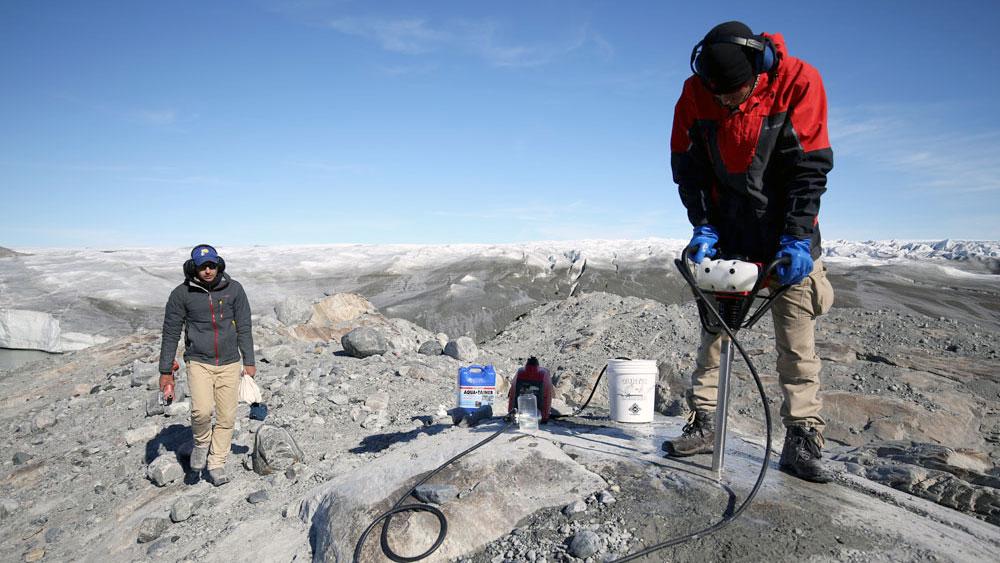If the Greenland ice sheet melts, what happens to New York City? This reporter went to find out.
Researchers drill a core sample in Greenland. Their research has shown that the island has spent much of the last million years completely ice-free — which challenges what scientists thought they knew about Greenland.
Listen to the three-part series
Part 1
Part 2
Part 3
The night Superstorm Sandy hit New York City, I was stationed at NPR’s deserted New York bureau. I was there as the backup. If WNYC were to lose power, I would go live on the air with essential, perhaps lifesaving information for our listeners.
Our skeleton crew stood speechless at times that night, watching the wind blow torrential rain sideways. We heard an eerie pop followed by what looked like fireworks. Apparently, a transformer blew and the city’s iconic skyline went dark — the power was out below 34th street.
This was no ordinary storm.
“Hurricane Sandy was the worst natural disaster that ever hit New York City,” said Daniel Zarrilli, New York’s senior director of climate policy and programs.
Forty-four people died. Economic losses totaled $19 billion.
The flooding was unprecedented. In lower Manhattan alone, previous flood records were exceeded by about 4 feet. When I finally returned to my Brooklyn apartment a few days later, my husband, Kent, filled me in — the ceiling of our top floor walkup had leaked again — and he was still cleaning up bits of drywall and water stains from the wood floor of our living room/kitchen area.
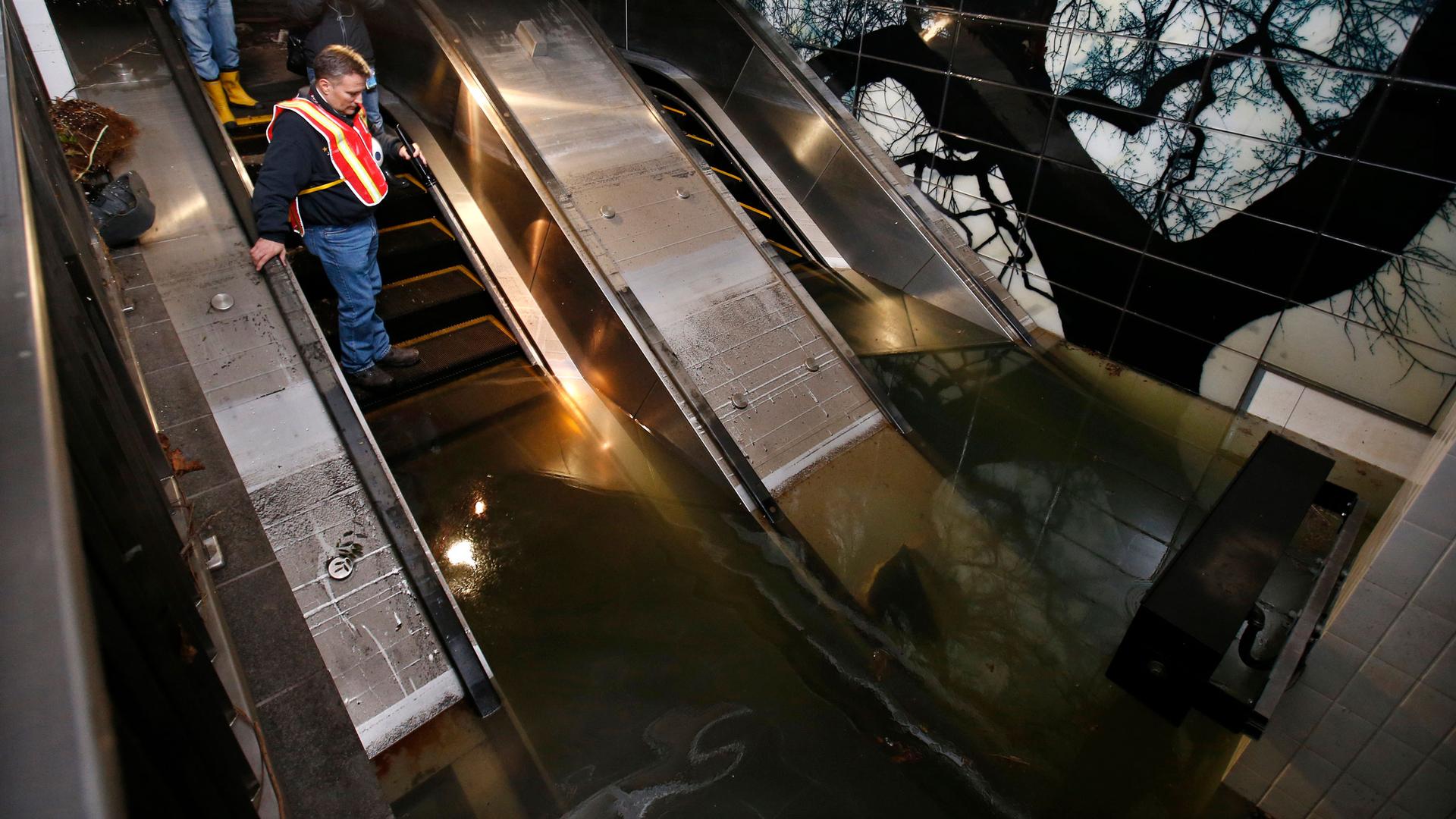
Millions of gallons of salt water filled up buildings, basements, and subway tunnels, including the one that I ride to get from Brooklyn to Manhattan.
Some train lines were closed for months after the storm.
And now, more than five years later, some of them still aren’t fixed. One crosstown train that also carried about 400,000 daily riders between Manhattan and Brooklyn is shutting down for more than a year beginning in January 2019, for repairs and improvements linked to Sandy.
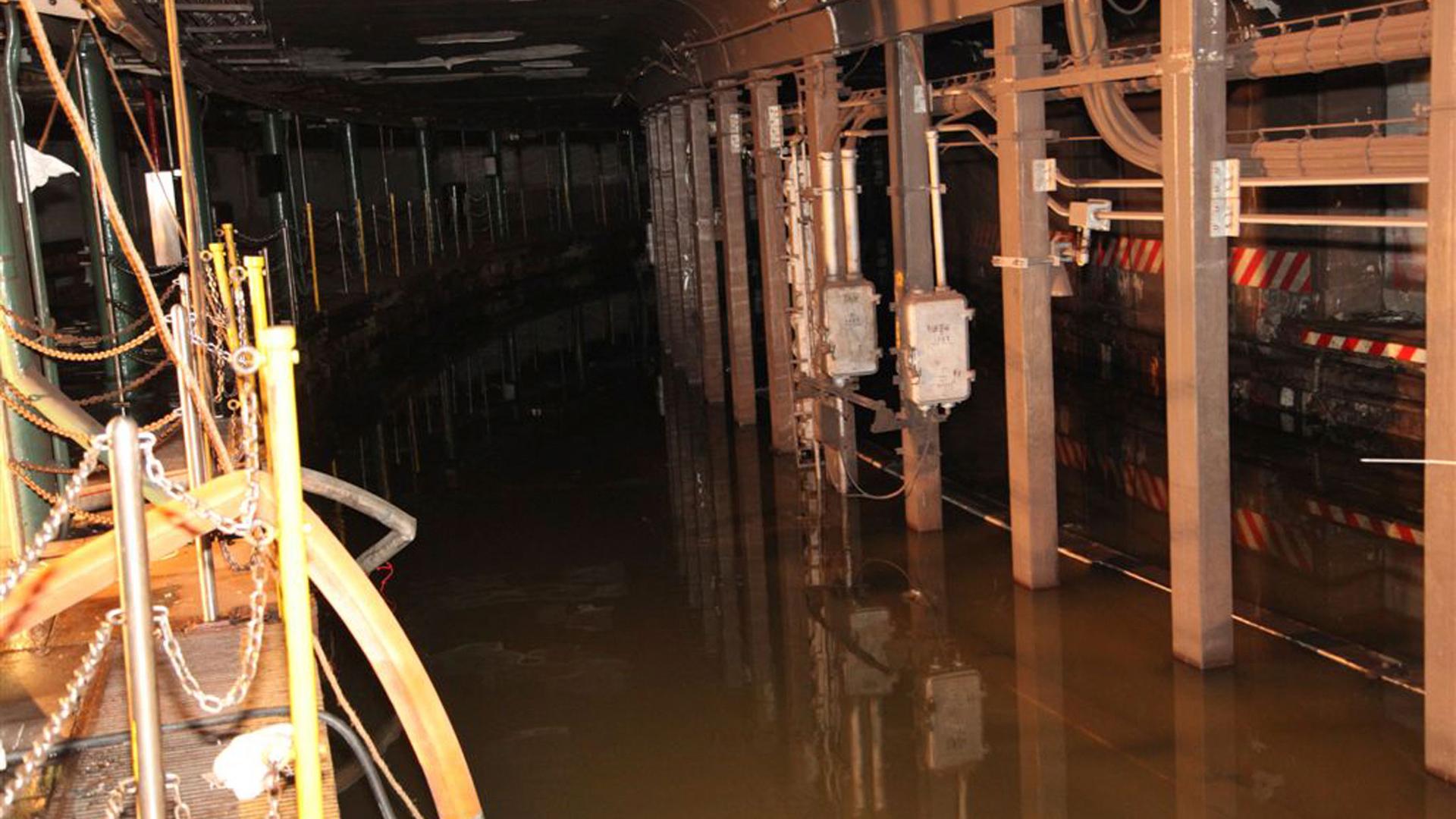
But while the city is fixing all the stuff that broke down the last time, what about the next storm? Because all the experts keep telling us there will be a next time, that Sandy was just a climate change foreshadow of what’s to come for this part of the country.
But where is all this water coming from? Why are we seeing so much more flooding in New York City and other parts of the east coast?
I decided to dig in and search for answers. I’ve covered science and innovation for Marketplace and other public radio stations, so I naturally turned to my reporter’s instincts. I applied for and received a competitive grant from the venerable Institute for Journalism and Natural Resources. I was selected for a fellowship at the Woods Hole Oceanographic Institution, or WHOI, on Cape Cod, where I spoke to key researchers who have been studying the world’s ice sheets and sea levels for decades. Sea level is rising globally as human pollution helps the atmosphere to warm up, and some of that extra heat transfers to the oceans, causing the water itself to expand. The warmer atmosphere is also causing ice to melt around the world and flow into the sea — from glaciers, and from the polar ice caps in Antarctica and Greenland.
But that sea level rise isn’t uniform.
“The northeastern US is an area where, what we call regional sea level, is rising three to four times faster than the global average,” explains WHOI glaciologist Sarah Das.
Das says that’s partly because of a very local phenomenon. “The land of the Eastern Seaboard of the United States is actually in these places subsiding.”
But she says it’s also because ocean currents in the region are slowing down.
To figure out why, Das and other scientists look to the Greenland ice sheet for raw data.
“It’s an archive of how climate has changed in the past and in the long past — you know, a hundred thousand years,” said Joel Harper, a glaciologist at the University of Montana.
Related: In Greenland, a climate change mystery with clues written in water and stone
Related: Looking small for big answers in Greenland
He relies on the ice sheet to get highly detailed information on temperature and precipitation changes in the northern hemisphere.
Meltwater released from the ice sheet is also affecting the east coast. Harper said the fresh water is changing the salinity of the ocean and that, in turn, is changing ocean circulation patterns. That could affect New York’s precipitation and climate.
“The ice sheet influences the atmosphere and influences the oceans and actually helps drive how the climate system works,” Harper added.
Clearly what’s happening in Greenland isn’t staying in Greenland. So I decided to try to get there myself, to see first hand this important contributor to New York’s sea level rise, and join scientists trying to see into its future.
It took some time, but I finally lined up an excursion.
Eventually I was able to hop onto a C-130 plane, courtesy of the New York Air National Guard — there are no direct flights to Greenland from the states — then onto an Air Greenland helicopter paid for by the National Science Foundation, before being dropped onto a crusty moonscape about a mile from the Greenland ice sheet.
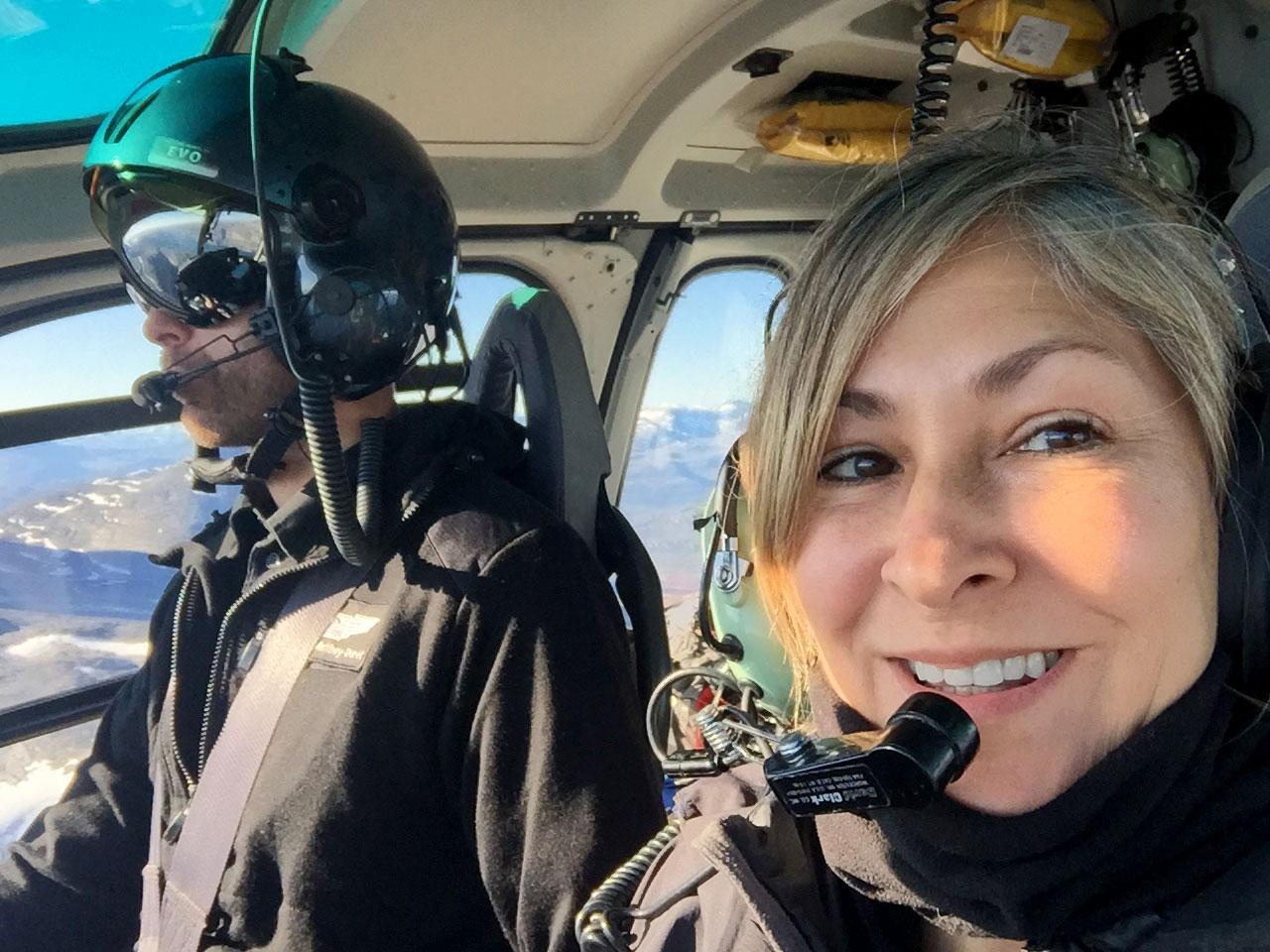
Camping under the midnight sun
The fire engine red chopper feels bigger than it looks. The terrain we’re flying over looks unforgiving. But I’m reassured by the chipper French pilot giving me instructions to buckle up and not touch the door handle unless he says so.
After an awe-inspiring sprint across Baffin Bay, we sidle right up to ancient peaks of rocky quartz. These are some of the oldest rocks on earth. They jut upwards in craggy peaks that make for a harrowing helicopter ride. At one point it looks like we are heading straight towards them!
But the pilot pulls up last minute and gives me a smile. Just another day for him!
After about 45 minutes, we land on a pebbly slope, next to a pristine blue lake.
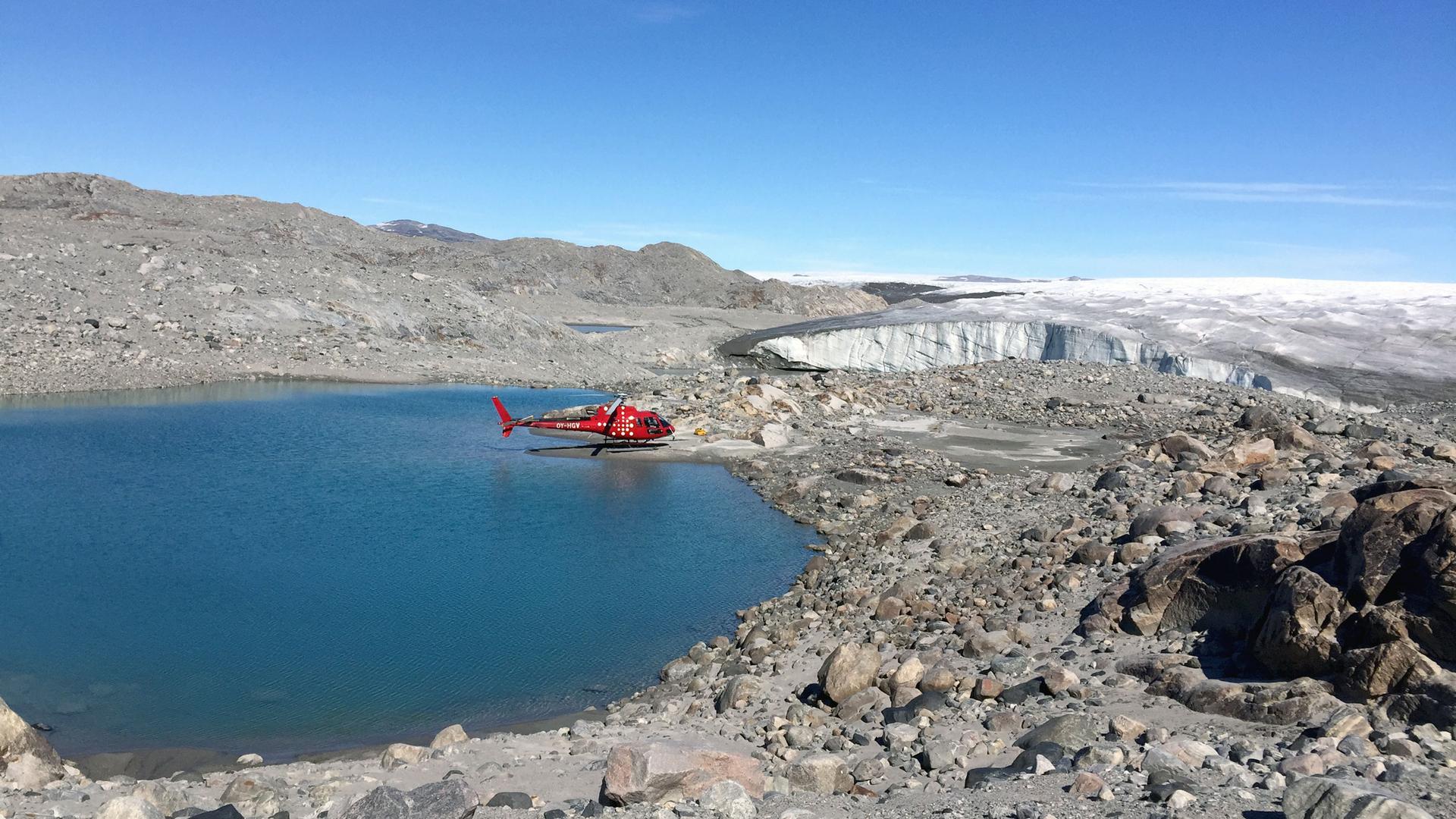
“You know how to open the door?” the pilot asks me.
“Oh, we’re allowed to?” I ask. (Before he’d said not to touch it!)
“Yes, now,” he answers.
So I step out onto the edge of the Greenland ice sheet.
It’s a stunning sight. The ice rises up and spreads out flat, like a mirror.
I’m immobilized by the view, but the four researchers I’m here with are already on the move, searching for a campsite.
“We have fresh water, a flat place to put our tents,” says Jason Briner of the Paleoclimate lab at the University at Buffalo. “We’re close enough to the lake so that that we can get our gear and boats to the water. Yeah, it’s good!”
Briner and Nicolás Young of the Lamont-Doherty Earth Observatory at Columbia University are joined by University at Buffalo Ph.D. students Brandon Graham and Allison Cluett.
Briner has been coming here with his students for a decade or so to collect rocks and lake sediments, pieces of Greenland that can date back thousands of years.
“The samples we’re collecting are helping us understand how the ice sheet has changed in the past,” Briner explains. “It allows us to get a longer-term glimpse of how the ice sheet responds to climate change.”
From these samples, Briner and Young know the Greenland ice sheet used to be bigger than it is now.
Certain chemical and biological properties of the rocks and lake bed can help the researchers understand how the ice sheet melted in the past, and what earth’s climate was like back then.
“If we can reconstruct in detail how the ice sheet may have behaved during previous warm periods, the hope is that it gives us some preview on what the ice sheet might do in the next 100, 200 years and beyond,” Young explains.
If we know what the ice sheet’s going to do, we can be a lot more certain how much the ocean’s going to rise. But getting a good fix on that is taking years of sampling.
That’s why these guys and lots of other researchers keep coming back here.
But before we get to the science, we’ve got to set up our homes for the week — individual tents for sleeping and a big mess tent for eating and gathering together as a group.
I wondered why we all slept in single tents, but the group assured me that spending 14 hours a day together hiking and working was enough — we all needed our privacy. They were right.
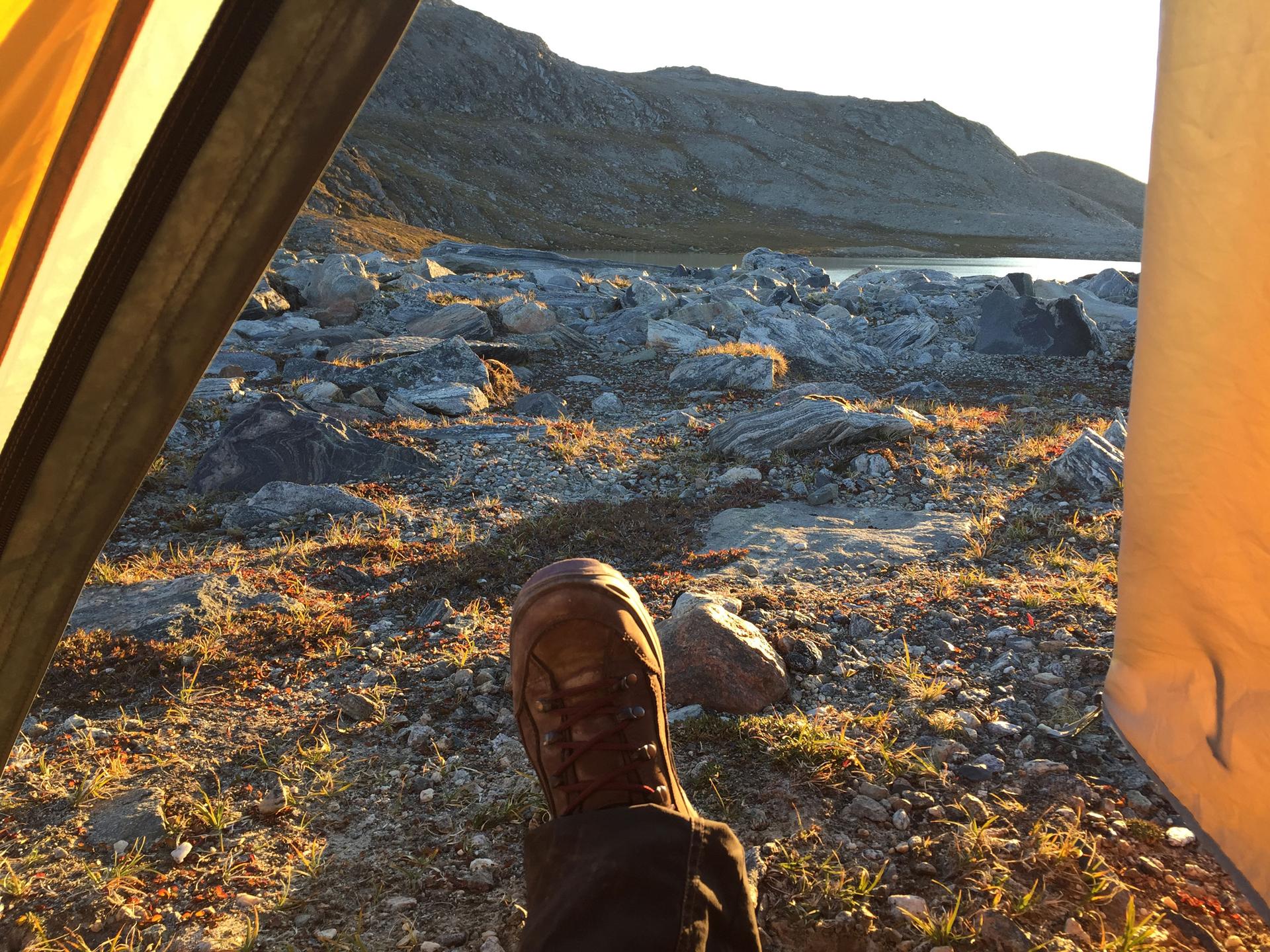
Surrounded on three sides by the ice sheet, sitting atop these barren high plains with shrub grass and rocks, it’s hard to find a soft, flat spot for camp. It feels like we’re in a wind tunnel, as the gales form on the ice sheet then barrel down through the treeless plains and frigid lake water and fast-moving streams.
I get a quick lesson in tent setup: how to hammer stakes and plop heavy rocks down on tent corners. I’ve never been the outdoorsy type.
Don’t get me wrong — I’m incredibly drawn to nature. But as an undersized, only child who studied ballet as a kid, I was incessantly teased for being scrawny and weak. As a result, I never did this kind of stuff. I just stood by, embarrassed by my ineptitude. But I’m about to break free of my past here.
“Does that go on top of this then?” I ask.
“Yeah, that’s called a rain fly,” Briner tells me patiently.
He also gives me tips for staying warm overnight. Daytime temps are around 50 degrees or warmer, but at night it will dip below freezing and that’ll be exacerbated by the ceaseless wind off the ice sheet.
We have a quick dinner as the all-day sun dips low in the sky.
Back in my solo tent, I double up my socks, zip up my sleeping bag on loan from the National Science Foundation, and listen for caribou and Arctic fox. I’m sort of hoping for a hot flash, but it doesn’t come. I shiver myself to sleep, thinking, “I am going to do this, no matter what.”
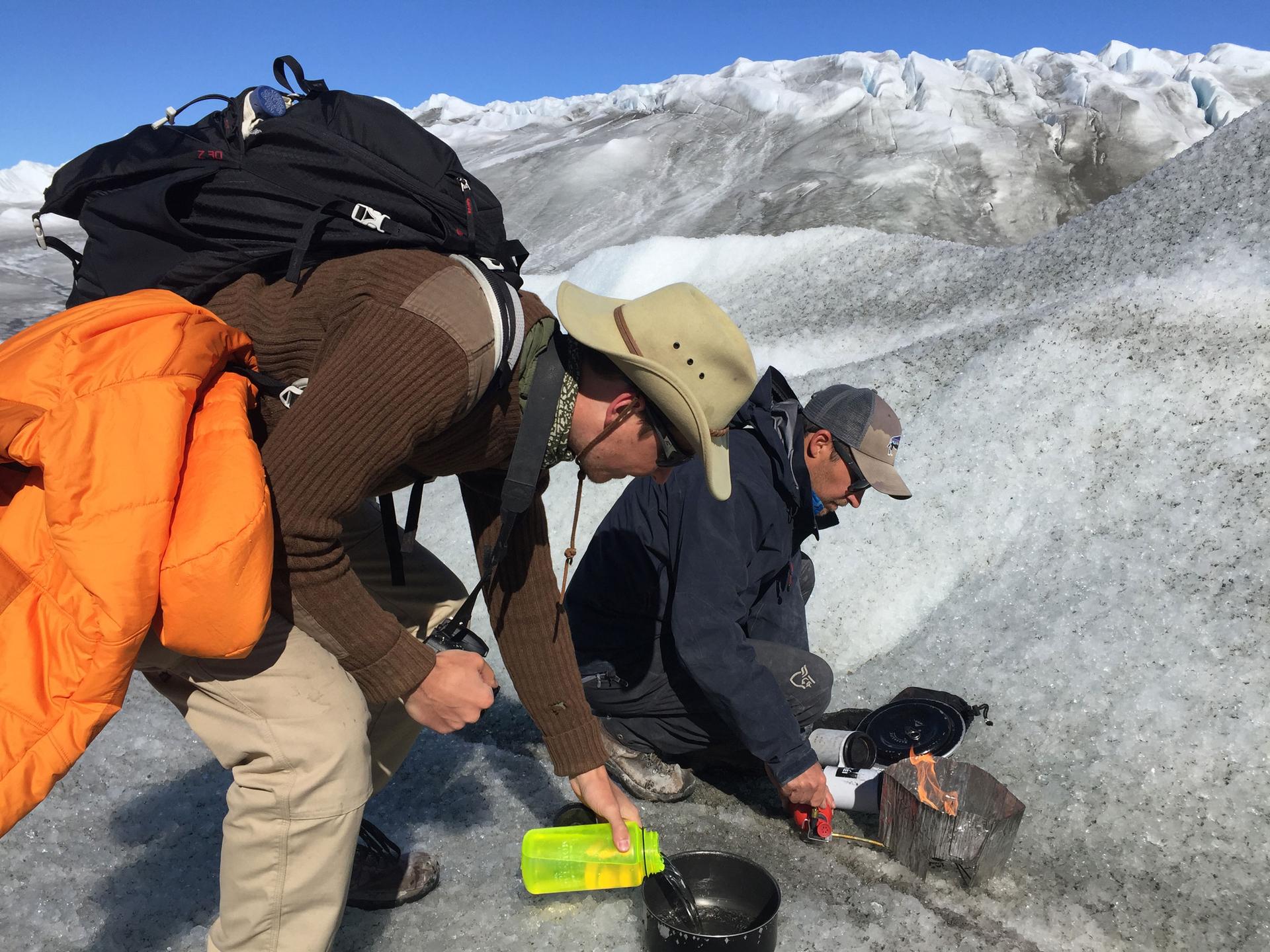
‘… the data are hard to refute …’
Despite Briner’s tips, nighttime in the summer here takes some getting used to. Even though the sun slips below the horizon for a while, it does not get dark. But as Briner warned, it does get cold. Between the light and the chill, I sleep badly our first night out, so the coffee brewing when I arrive in the mess tent the next morning is a very welcome thing.
There’s also oatmeal and toast — some of the comforts of home to get us moving on this first full day of the expedition. Before we head out, though, Briner needs to check in by satellite phone with the federal contractors who are providing logistical support. And while he does, I’m reminded of some of the advice they sent me in their prep sheets for this trip.
“An agitated musk ox will sway its head from side to side,” read one tip. Steer clear! And: “If an Arctic fox attacks, fight back and defend yourself.”
This is why I brought along my first ever Swiss Army knife, which everyone on this trip really does carry with them.
After the call, Briner makes the announcement: it’s time — time for our first full day of fieldwork. We head out into the wind, on the hunt for rock and lake sediment samples.
The researchers need those bits of Greenland to help improve our understanding of how the ice sheet here has changed over time, and where it might be headed as the world quickly warms up.
That’s crucial because there’s a huge amount of ice in Greenland, enough to raise global sea levels by around 25 feet if it all melted. How much and how fast it will melt is a gigantic question mark. And it’s taken on even more urgency after a recent discovery.
Not long ago, scientists thought the ice sheet here had stayed more or less intact over the last few million years, that it grew and shrank through cool and warm periods, but that overall, Greenland stayed locked up in a huge block of ice.
“I was really surprised,” he says. “But the data are hard to refute.
The data comes from new measurements of some old bedrock collected 25 years ago from beneath the thickest part of the Greenland ice sheet.
The team used improved technology to analyze the rock. They isolated grains of quartz and found some unexpected isotopes — tiny variations in the elements that make up the rock.
“The only way those isotopes can get there,” says Briner’s expedition co-leader Nicolás Young, of the Lamont-Doherty Earth Observatory at Columbia University, “is if the ice sheet has completely disappeared and exposed that bedrock site.”
Exposed it to cosmic rays, from space. Cosmic Rays are constantly buffeting the earth, but they don’t penetrate ice very well.
“And so based on these measurements,” says Young, who collaborated with Briner and others on that research, “we thought that it was extremely likely that the ice sheet disappeared at least once if not more times during the past few million years.”
In other words, all this ice seems to have melted before, during warm periods not unlike the one we’re already heading into.
That conclusion challenges what we thought we knew about the history of Greenland. It also suggests something else: That computer models showing that the ice sheet Greenland won’t completely melt in the future could be wrong.
That is a very scary thought. But it resonates with what some other scientists are seeing too. They say that Greenland’s changing very quickly these days — Antarctica too — and sometimes in ways that they hadn’t expected.
So now, Young says, “the concern is, are we reaching some threshold in our climate system where we’ve triggered that runaway melt and runaway ice sheet demise?”
It’s the big question, but the answer remains unclear. Among other things, scientists are pretty sure that the last time the earth was just a bit warmer than it is today, Greenland’s ice sheet did not melt away.
So what gives? We still just don’t know. That’s why these guys are here. The more samples we can collect this week, the more data there will be to help understand Greenland’s past and perhaps get a clearer view of our future.
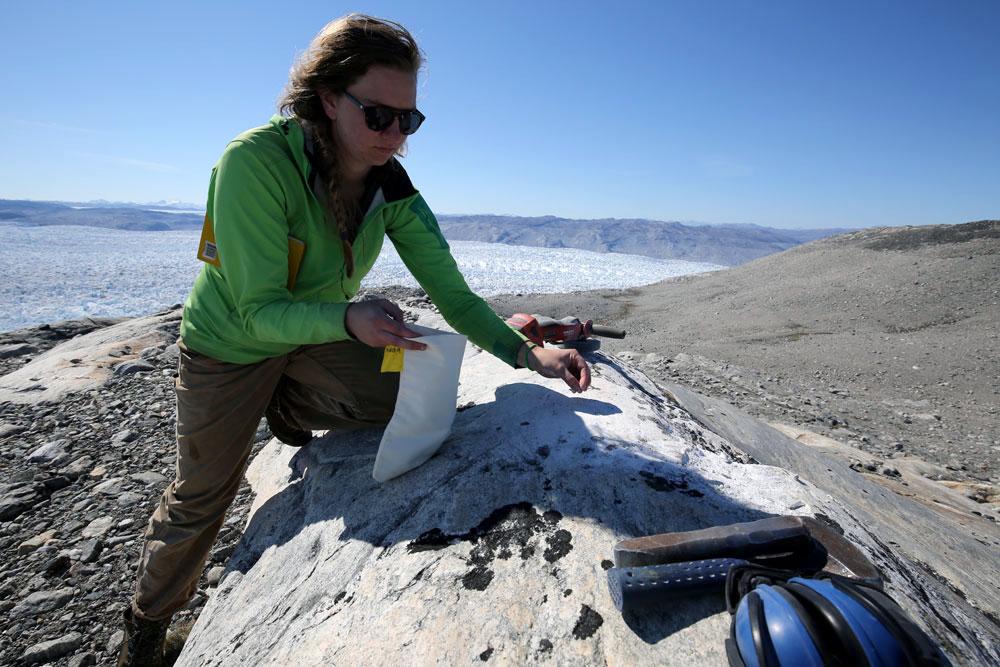
With supplies in our packs, we trudge over lichen-covered boulders, up and down treeless hills, until suddenly there it is, just sitting on the open ground, a geologist’s dream of a rock sample — lots of that key mineral quartz that they’re looking for, clean and easy to get.
Young hops onto the 10-foot tall boulder, grabs an electric saw and rough-cuts a section. Then he delicately coaxes off a slim layer with a hammer and chisel, labels it and stashes it in his pack. And we head off in search of the next big rock.
This goes on well past lunchtime, as far as I can tell, but we’re nowhere near done. And no one else appears tired, just me.
We also have to collect sediment samples from the bottom of a glacial lake, another piece of the ice sheet puzzle.
“The layers of mud that accumulate in lake bottoms, we can read like the pages of a book almost,” Briner says. “It’s a library of information.”
The mud contains silt and organic matter that hold clues to things like temperature and vegetation going back thousands of years.
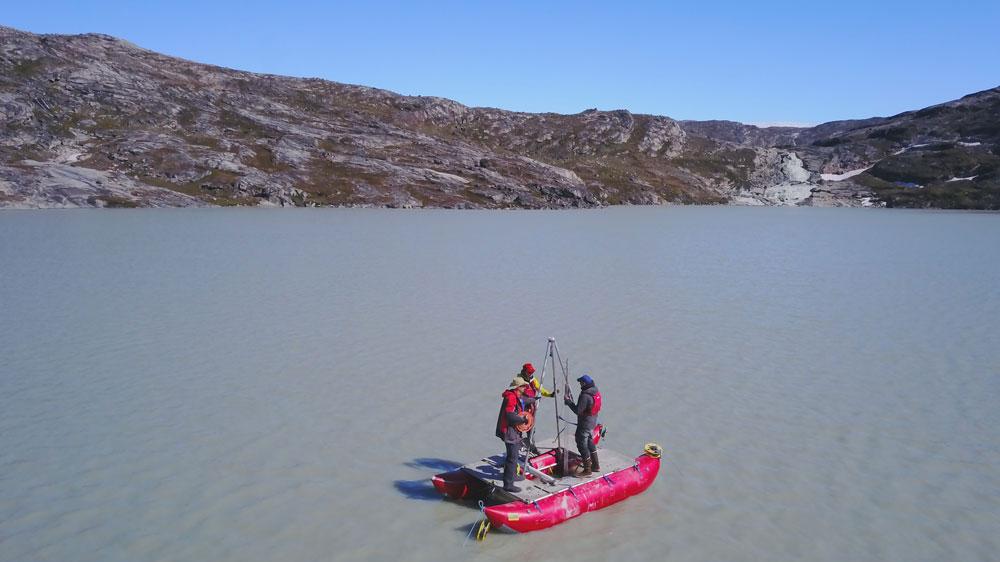
We head out onto the water on a motorized raft. The lake is turquoise, and frigid. When I dip my hand in, it comes out nearly numb.
We anchor in the deepest part of the lake. Briner and Young stand in the wind near the center of the raft and push a ten-foot plastic tube into the bottom of the lake, and I try not to think about what would happen if I fell off this flimsy sheath.
When they pull the tube up, it’s filled with layers of grey muck.
“It’s a good core,” Briner says, but when he tries to measure how much silt the tube collected, his tape measure keeps slipping. Turns out it’s broken.
Briner casts about for an on-the-fly fix. A hair tie maybe?
I’ve got a bunch. They’re like my zip ties, I tell him.
I give him one and it does the trick. Hair tie to the rescue! I have officially earned my keep on this expedition.
I’m exhausted as we head back to camp, but elated. I’ve somehow managed to do my small part for climate change science.
‘… this ice that we’re standing on is thousands of years old …’
We spend five days camping and collecting samples on what’s called the margin — the nearly barren area about a mile from the actual ice sheet. It’s covered in ancient rocks, with a few shrubs and Arctic flowers here and there, but not much vegetation. Although this is my first camping trip since I was a little kid, I am beginning to feel like pro.
We’ve slept in tents through the midnight sun, anchored catamarans in icy lakes and trudged up and down the glacial moraines searching for rock samples.
For most of the last few days, Briner and his colleagues have been sampling older rocks, hoping their chemistry and location will provide clues to the history of Greenland — how warm or cold was it at particular times throughout history and how much ice was there. But today, we stopped to sample the younger glacial rocks and debris, called moraines, that settled out as the ice sheet receded.
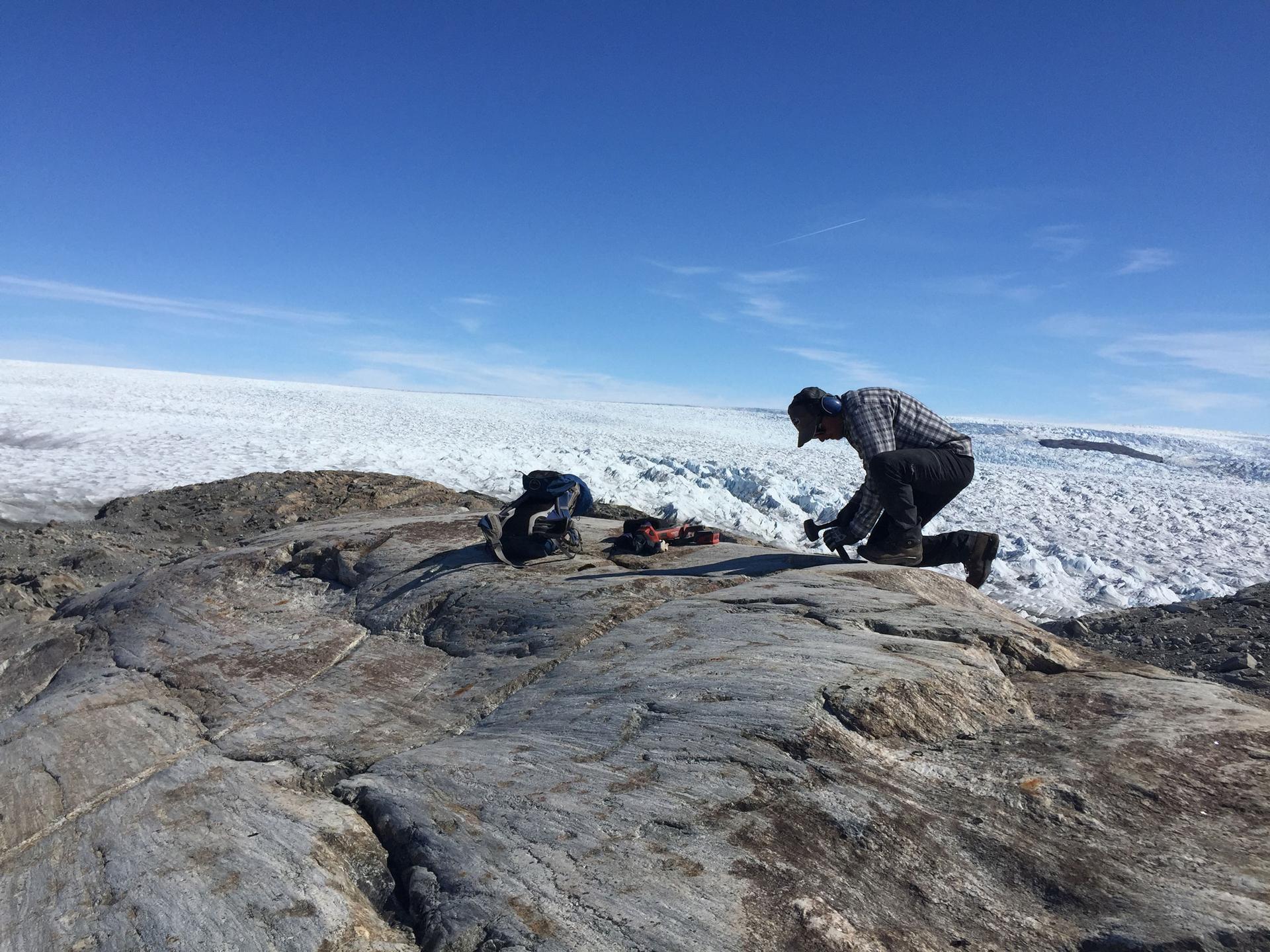
“It’s like an analog or an example of what the landscapes we normally study would have looked like thousands of years ago and so it’s actually really useful for us to calibrate our eye and to understand the processes of how moraines get deposited,” he says.
The team first wants to map the area to find the safest path, so it pulls out a drone. It sounds like a toy airplane, controlled by a remote device. Drones are revolutionizing field work — they can map topography in minutes that would have taken hours to figure out on foot.
Now, it’s time to step onto the ice shelf.
With the drone info in hand, we begin to angle our ascent over the steep terrain that’s covered with loose rocks. We climb in a vertical line, making sure to keep distance between each other in case a loose rock dislodges. The wind doesn’t help.
I’m doing all this while holding a big microphone and wearing clunky headphones. There’s also a fancy camera around my neck and I’m stopping to snap photos from time to time. It wasn’t long before I lost my balance.
Part way up, I fell for the first time all week. I quickly lost the expensive headphones — I’m not even exactly sure when they came off. Then, I watched as my special low-glare sunglasses ended up in a crevasse. I was embarrassed about this, like it somehow reflected a lack of sportsmanship or hiking ability.
It took a lot of effort; some of the trails were uphill climbs over rock piles. Then we’d get to a rushing river of ice sheet meltwater and have to cross it.
But after a last push, we’re finally on the ice sheet itself, as opposed to just camping next to it. It looks kind of like it does on a globe — blindingly white and uniform. Upon close inspection though, the ice is covered in soot and is somehow porous.
“First of all, how cool is it that we’re standing on the Greenland ice sheet?” Briner said. “We’re standing on bare ice, so if you walk around, you can hear the crunch because this ice that we’re standing on is thousands of years old, it might be 10,000 years old, and it comes from deep within the ice sheet.”
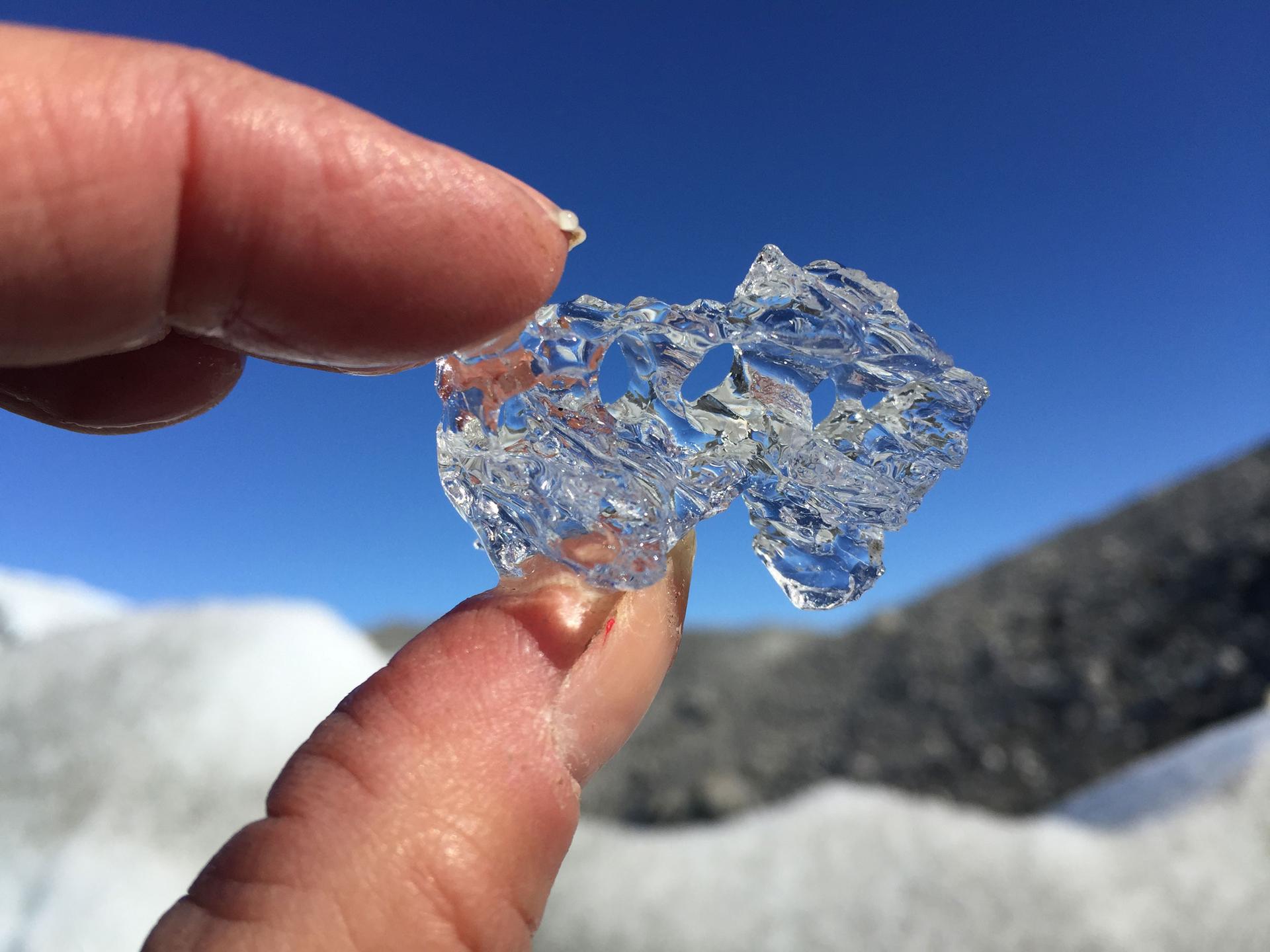
We walk around just to hear the crunching sound, take in the majesty of the ice. We cautiously peer into the arctic blue crevasses that sound like the inside of a conch shell times a thousand. Briner said it’s possible that some of them lead all the way down to the bottom of the ice.
Briner hopes all this geologic history we’re gathering will help create better computer models of Greenland’s future in a warming world so we can better predict how much ice will melt, how fast, and what it all means for sea level rise in cities like New York.
As the wind picked up, we realized we had to get back to camp. We crossed back over the rushing waterfalls and fast moving glacial lakes. We stepped gingerly over piles of rock debris left behind by the retreating ice sheet.
After a few hours, we make it back to camp. We’re tired, punchy and hungry.
“Should we order pizza?” joked Briner.
We all laugh and know that’s impossible — we’re hundreds of miles from even the smallest village or town, let alone a pizza joint.
“That would be $12,000 pizza,” said Young, factoring in the cost of a helicopter.
We all ponder how we’d go about expensing that pizza. When we look up, Briner has a present for everyone: cold cans of beer! After seven days without creature comforts, we all start clapping and toast to a successful trip.
The next morning we ship out.
Briner and the other researchers are heading off to a site in another part of Greenland, and I’m heading back to New York via Iceland.
‘… the first data ever that keeps me awake at night …’
It takes months, sometimes more, for samples collected in Greenland to get worked over in the lab. So the research team from the trip is still analyzing its data for any new conclusions about the ice sheet. It will be months still before there are any new clues about what might be ahead for my city.
Meanwhile, though, I’m still wrestling with the impact of some of the team’s earlier findings. And remarkably, so are they.
“It’s the first data ever that keeps me awake at night at times because it is so alarming,” said Joerg Schaefer at Columbia University’s Earth Institute.
Schaefer is the lead author on the research that both Briner and Young have collaborated on, which was first published in 2016.
He led the team in collecting the precious bedrock samples that yielded those new results that call into question what we thought we knew about the ice sheet.
“It’s the first direct evidence we have that Greenland has been ice-free for substantial periods over the last million years,” Schaefer said. “And we don’t understand that.”
In a climate similar to today’s, the ice sheet all but completely melted away.
It’s not what we thought we knew about Greenland, Schaefer said.
“We don’t understand this,” Schaefer said. “We don’t have a model or any kind of process understanding how this can happen. And given the extreme warming of the Arctic at the moment that’s going on and given these really strong signs of the Greenland ice sheet that we observe today from modern observations, this is a really scary story.”
A total melting of the Greenland ice sheet would raise sea levels by roughly 25 feet. Schaefer says he’s not scared that will happen again anytime soon. Other researchers aren’t sure it will happen at all. But Schaefer says even half a foot of sea level rise from Greenland is possible by the end of the century. That, he says, would be a “disaster for society.”
But it would still be a creeping disaster, one too slow to register in most people’s daily lives — except when the coast gets hit by big storms.
After I came back from Greenland, I moved out of Brooklyn to Wall Street. Dozens of buildings in this part of town flooded. Some lost power and elevator service. And subways stations in this area of downtown were closed — in some cases, for months. The trains are up and running, but not much has changed.
A few towers have moved their electrical systems to higher floors. The city has rebuilt some parks to hold more water during storms.
And there’s talk of bigger changes. The US Army Corps of Engineers recently began holding public meetings on whether to build berms, seawalls and storm surge barriers along New York’s shoreline. But those plans would take decades and billions of dollars to implement.
I went to Greenland to try to get a better fix on how the future of the ice sheet could affect my city. But what I learned is that while details will continue to evolve, we know enough already that we should be doing a lot more to protect coastal cities from climate change and sea level rise.
If I thought the trip would allay my fears, I was wrong. Seeing the ice up close made me realize the vastness of the world’s loss.
Like my neighbors, I’m nervous about the next storm — how the flooding could keep getting worse while our government focuses on the smaller picture. I contemplate where I could move, but east coast options are limited. In New York City, just about every neighborhood could be impacted.
Each new storm, I wonder if I’ll be isolated, holed up in some broadcasting studio again, or out in the field following another disaster. Every subway ride I’m careful to bring a filled water canteen, aspirin, contact lens solution. Will I have to report on immediate impacts of potentially higher flood waters? I want to be prepared — it’s what adulting is about — being prepared, right?
And then I remember the Greenland findings that now keep scientist Joerg Schaefer up at night. We have a lot more to learn and lot more to prepare for.
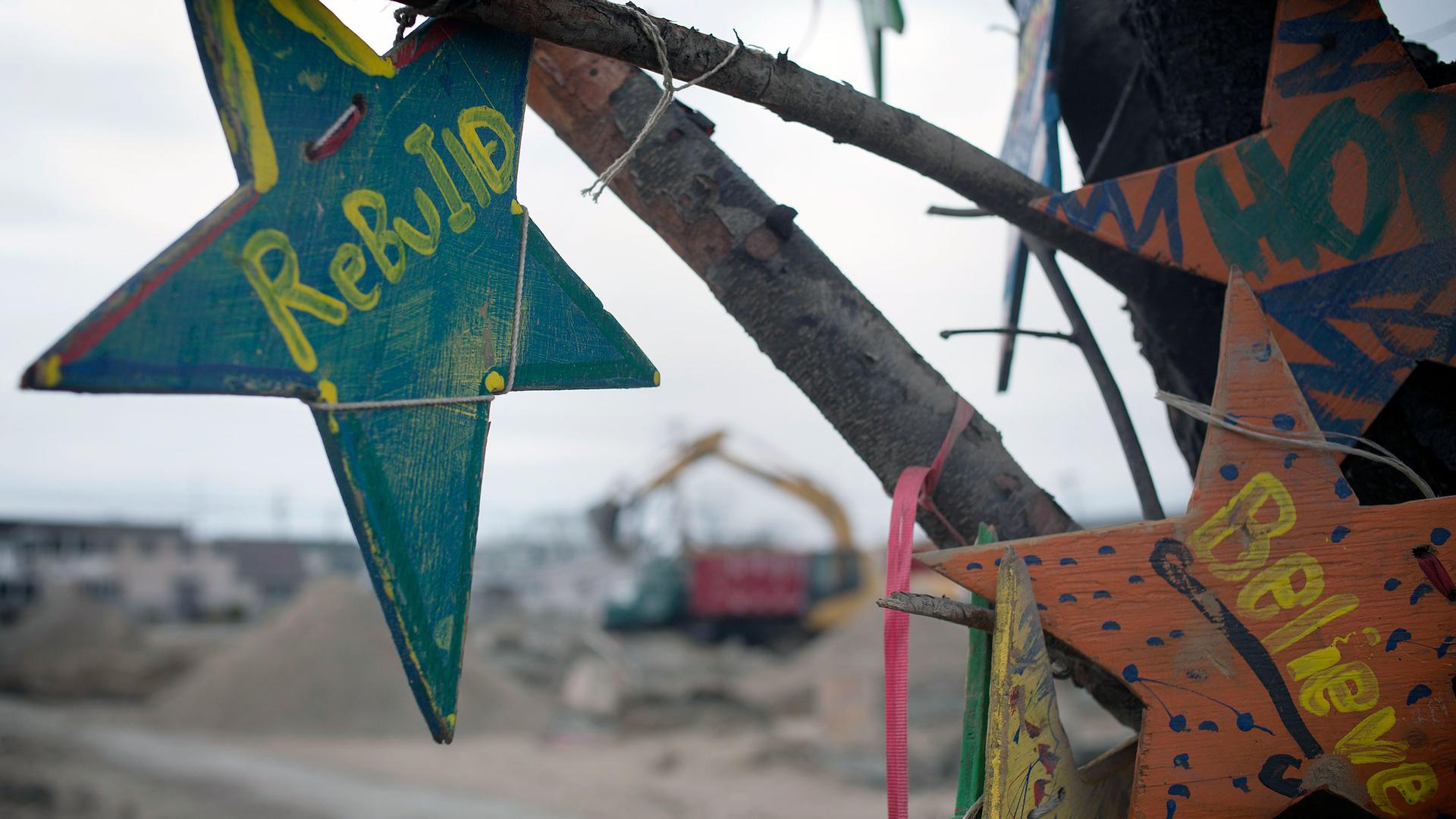
Editor’s note: This story was produced in part thanks to a reporting grant from the Institute for Journalism and Natural Resources and with material support from the National Science Foundation and the New York Air National Guard.
This story has been updated to correct the spelling of Nicolás Young’s name and to clarify that Professor Joerg Schaefer was the lead author of the 2016 paper that indicates Greenland has been ice-free in for long periods over the last million years.
